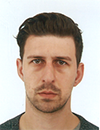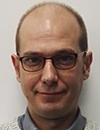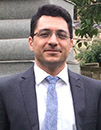
|
Director(s): Prof. Zabih. Ghassemlooy - Northumbria University, UK , Dr. Paul Anthony Haigh - Newcastle University, UK , Dr. Andrew Burton - Northumbria University, UK , Dr. Mojtaba Mansour Abadi - Northumbria University, UK
|

|
Registration deadline: Undefined
|

|
Cost: Free
|
✓ Objectives and notes
Create Account
This short course will provide students with the foundation knowledge required to utilise MATLAB to design digital communications systems from the fundamental mathematical equations. The course will cover the generation of key modulation formats including phase shift keying (PSK), pulse/quadrature amplitude modulation (PAM/QAM) and orthogonal frequency division multiplexing (OFDM). Light-emitting diodes (LEDs) will be mathematically modelled in terms of their electrooptic and frequency responses for transmission over a free-space optical channel with a direct detection receiver. Finally, demodulation will be described mathematically including how to implement simple digital signal processing routines for equalisation, data recovery and bit error rate testing.
Duration: 2 Hours
Biographies:
 Professor Zabih. Ghassemlooy, CEng, Fellow of IET, Fellow of OSA and Senior Member of IEEE received BSc (Hons.) in electrical and electronics engineering from Manchester Metropolitan Univ., UK in 1981, and MSc (1984) and PhD (1987) from Univ. of Manchester, UK. From 1987 to 1988 was a Post-Doctoral Research Fellow, City Univ., UK. In 1988 joined Sheffield Hallam Univ. as a Lecturer, becoming a Professor in 1997. In 2004 joined Univ. of Northumbria, Newcastle, as an Associate Dean (AD) for research in School of Engineering, and from 2012 to 2014 was AD for Research and Innovation, Faculty of Engineering and Environment, where he currently is Head of the Optical Communications Research Group. In 2001 was awarded Tan Chin Tuan Fellowship in Engineering from Nanyang Technological Univ., Singapore. In 2016 was a Research Fellow and in 2015 a Distinguished Professor at Chines Academy of Science, Quanzhou, China. Visiting Professor at the Univ. Tun Hussein Onn Malaysia (2013-17), and Huaqiao Univ., China (2017-18). Published over 850 papers (330 journals and 8 books), 97 keynote/invited talks, and supervised 65 PhDs. Research interests include optical wireless communications, free space optics, visible light communications, radio over fibre- free space optics, and sensor networks with project funding from EU, UK Research Council and industry. He was the Vice-Chair of EU Cost Action IC1101 (2011-16). He is the Chief Editor of the British Journal of Applied Science and Technology and the International Journal of Optics and Applications, Associate Editor of a number of international journals, and Co-guest Editor of a number of special issues. He is a co-author of a CRC book on “Optical Wireless Communications – Systems and Channel Modelling with Matlab (1st Ed. 2012, and 2nd Ed. 2019); a co-editor of four books including the Springer book on “Optical Wireless Communications – An Emerging Technology (2016)”, CRC book on “Visible Light Communications: Theory and Applications, June 2017”, IGI Global book on “Intelligent Systems for Optical Networks Design: Advancing Techniques, 31 Mar 2013, and IET book on “Analogue Optical Fibre Communications, IEE Telecommunication series 32, 1995”. He is the founder and chair the IEEE/IET Intern. Symposium on Communications Systems, Networks and DSP, West Asian Colloquium on Optical Wireless Communications, and co-founder of a number of international events including Workshop on Optical Wireless Communications in ICC since 2015. He is the Vice-Cahir of OSA Technical Group of Optics in Digital Systems (2018-). He is the Chair of the IEEE Student Branch at Northumbria University, Newcastle (2019-). From 2004-06 he was the IEEE UK/IR Communications Chapter Secretary, the Vice-Chairman (2006-2008), the Chairman (2008-2011), and Chairman of the IET Northumbria Network (Oct 2011-2015).
Web site: http://soe.northumbria.ac.uk/ocr/people/ghassemlooy
 Dr Paul Anthony Haigh received his B.Eng and PhD degrees from Northumbria University, Newcastle upon Tyne, UK, in 2010 and 2014, respectively. Between 2011 and 2012, Dr Haigh was awarded the prestigious Marie Curie Fellowship at the European Fellowship for Nuclear Research (CERN). During his PhD, Dr Haigh studied the performance of organic photonic devices in the context of visible light communications. He did post-doctoral research at the High-Performance Networks group, University of Bristol from 2014-16 and at the Communications and Information Systems group, University College London from 2016-2019. Dr Haigh is now a Lecturer in Communications and Signal Processing at Newcastle University focusing his research activities on translative visible light communications systems. Dr Paul Anthony Haigh received his B.Eng and PhD degrees from Northumbria University, Newcastle upon Tyne, UK, in 2010 and 2014, respectively. Between 2011 and 2012, Dr Haigh was awarded the prestigious Marie Curie Fellowship at the European Fellowship for Nuclear Research (CERN). During his PhD, Dr Haigh studied the performance of organic photonic devices in the context of visible light communications. He did post-doctoral research at the High-Performance Networks group, University of Bristol from 2014-16 and at the Communications and Information Systems group, University College London from 2016-2019. Dr Haigh is now a Lecturer in Communications and Signal Processing at Newcastle University focusing his research activities on translative visible light communications systems.
 Dr Andrew Burton received the B.Eng (Hons) degree for communications and electronic engineering, M.Sc. degree in optoelectronics and communications, and a Ph.D in visible light communications from Northumbria University, Newcastle upon Tyne, UK, in 2007, 2008 and 2015 respectively. Andrew has since gone on to work within a collaboration between Northumbria University and the European Space Agency (ESA) to develop a simulation package for deep space to ground optical communications in 2016. Following this, he went to work for the International University in Ho Chi Minh City to help setup an optical wireless communications laboratory. On his return to the UK in 2017, he joined Northumbria University as a research associate for a joint project with University College London entitled ‘Multifunctional Polymer Light-Emitting Diodes with Visible Light Communications (MARVEL)’. His research interests include electronics, optical communications and visible light communications, in which he has more than 30 journal/conference publications. Dr Andrew Burton received the B.Eng (Hons) degree for communications and electronic engineering, M.Sc. degree in optoelectronics and communications, and a Ph.D in visible light communications from Northumbria University, Newcastle upon Tyne, UK, in 2007, 2008 and 2015 respectively. Andrew has since gone on to work within a collaboration between Northumbria University and the European Space Agency (ESA) to develop a simulation package for deep space to ground optical communications in 2016. Following this, he went to work for the International University in Ho Chi Minh City to help setup an optical wireless communications laboratory. On his return to the UK in 2017, he joined Northumbria University as a research associate for a joint project with University College London entitled ‘Multifunctional Polymer Light-Emitting Diodes with Visible Light Communications (MARVEL)’. His research interests include electronics, optical communications and visible light communications, in which he has more than 30 journal/conference publications.
 I was born in Fasa, Iran, in 1982. I received the B.Sc. degree in electrical engineering from Islamic Azad University, Fasa, Iran, in 2005, and the M.Sc. degree in electromagnetic fields and waves from the K.N. Toosi University of Technology, Tehran, Iran, in 2008 and in 2016 received my Ph.D degree in optical communication from OCRG, Northumbria University, Newcastle upon Tyne, UK. My research subject was hybrid free-space optical (FSO)/radio frequency (RF) communication systems in particular hybrid antennas. I also developed differential signalling technique for mitigation channel effects in FSO links. . From 2017 to 2018, I was as a research assistant in School of engineering, University of Glasgow, Glasgow, Scotland. I worked on high capacity FSO system using space division multiplexing (SDM), autonomous FSO alignment systems, as well as 1 Gbps underwater optical wireless communications. From July 2018, I returned to OCRG as a researcher to work on high-speed ground to train FSO link.
My research is mainly focused on FSO alignment system, optical array antenna, simulation software development and manufacturing communication systems.
|

